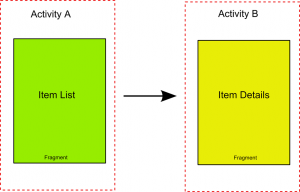在android3.0上开始引入了一个新概念叫fragment。它有自己的布局文件,可以作为组件排布,也可以相互组合去实现不同的布局显示。使用fragment可以重复利用代码,并且可以满足不同设备尺寸的需求。fragment不能单独存在,只能存在于activity中,而一个activity可以拥有多个fragment。很重要的一点是,fragment可以和activity中的其它组件一起使用,无需重写所有activity的接口。所以使用fragment就可以这样来完成上例中“主界面—详细界面”的app需求。
在手机上是这样显示的:

而在平板上是这样的:

在一个小屏幕的设备上,一个activity通常占据了整个屏幕,同时显示各种ui视图组件。activity实际上就是视图的容器。然后,当一个activity被显示在一个大屏幕的设备上,例如平板电脑,总会显得有些不适应。因为屏幕太大了,activity中的所有ui组件要充满整个屏幕,这样一来,视图的层次结构就很复杂了。一个更好的办法是使用一种“轻量级”的activity,每个“轻量级”activity包含自己的视图,互不干扰。在运行期间,根据屏幕的方向和尺寸,一个activity可以包含一个或多个“轻量级”activity。在android3.0以上的版本,这种“轻量级”的activity叫做fragment.
怎么创建一个fragment
现在我们了解了fragment的生命周期了,接着我们就需要知道怎么创建一个fragment并绑定到activity中,第一件要做的事就是继承android.app.fragment来写一个fragment,假设我们的fragment叫做fragment1,创建和定义如下:
|
1
2
3
|
public class fragment1 extends fragment {...} |
就像我们上面说的,fragment只能存在于activity中,所以我们必须要在某处定义它,有两种方式:
- 直接在xml布局文件中定义;
- 在xml布局文件中定义一个占位符,然后动态地在activity中操作fragment;
我们定义fragment的方式会影响它的生命周期,因为在上述第一种情况下oninflate方法会被调用,而第二种情况下它的生命周期是从onattach方法开始的。
如果我们在xml文件中定义fragment的话,我们需要:
|
1
2
3
4
|
<fragment android:id="@+id/f1" class="com.survivingwithandroid.fragment.fragment1" android:layout_width="match_parent" android:layout_height="20dp"/> |
然而如果我们在xml中用占位符的话,需要再做一些工作。
布局框架和fragment
如果我们在xml布局文件中定义fragment的话,就不能自由、动态修改fragment了,还有别的方法可以让我们可以更灵活地操作:使用时需要在xml文件中定义:
|
1
2
3
|
<framelayout android:id="@+id/fl1" android:layout_width="match_parent" android:layout_height="200dp"/> |
在activity里面还需要做一点工作,因为我们必须手动初始化fragment,然后把它“插入”到framelayout中。
|
1
2
3
4
5
6
7
8
9
10
11
12
|
public class mainactivity extends activity { @overrideprotected void oncreate(bundle savedinstancestate) { super.oncreate(savedinstancestate); setcontentview(r.layout.activity_main); fragment2 f2 = new fragment2(); fragmenttransaction ft = getfragmentmanager().begintransaction(); ft.replace(r.id.fl1, f2); ft.commit();} |
例子
可以把fragment想象成activity的另外一种形式。你创建fragments去包含ui组件,就像创建activities那样。但是,fragment总是被嵌在activity中。
下面来通过一个例子看一下流程:
1.创建一个名为fragments的工程。
2.在res/layout文件夹下,新建一个叫fragment1.xml的文件。
|
1
2
3
4
5
6
7
8
9
10
11
12
13
14
15
16
|
<?xml version="1.0" encoding="utf-8"?> <linearlayout xmlns:android="http://schemas.android.com/apk/res/android" android:layout_width="fill_parent" android:layout_height="fill_parent" android:background="#00ff00" android:orientation="vertical" > <textview android:id="@+id/lblfragment1" android:layout_width="fill_parent" android:layout_height="wrap_content" android:text="this is fragment #1" android:textcolor="#000000" android:textsize="25sp" /> </linearlayout> |
3.在res/layout文件夹下,新建一个叫fragment2.xml的文件。
|
1
2
3
4
5
6
7
8
9
10
11
12
13
14
15
16
17
18
19
20
21
22
23
|
<?xml version="1.0" encoding="utf-8"?> <linearlayout xmlns:android="http://schemas.android.com/apk/res/android" android:layout_width="fill_parent" android:layout_height="fill_parent" android:background="#fffe00" android:orientation="vertical" > <textview android:layout_width="fill_parent" android:layout_height="wrap_content" android:text="this is fragment #2" android:textcolor="#000000" android:textsize="25sp" /> <button android:id="@+id/btngettext" android:layout_width="wrap_content" android:layout_height="wrap_content" android:onclick="onclick" android:text="get text in fragment #1" android:textcolor="#000000" /> </linearlayout> |
4.main.xml中的代码。
|
1
2
3
4
5
6
7
8
9
10
11
12
13
14
15
16
17
18
19
20
21
|
<?xml version="1.0" encoding="utf-8"?> <linearlayout xmlns:android="http://schemas.android.com/apk/res/android" android:layout_width="fill_parent" android:layout_height="fill_parent" android:orientation="horizontal" > <fragment android:id="@+id/fragment1" android:name="net.learn2develop.fragments.fragment1" android:layout_width="0px" android:layout_height="match_parent" android:layout_weight="1" /> <fragment android:id="@+id/fragment2" android:name="net.learn2develop.fragments.fragment2" android:layout_width="0px" android:layout_height="match_parent" android:layout_weight="1" /> </linearlayout> |
5.新建两个类:fragment1.java和fragment2.java。
6.fragment1.java中的代码。
|
1
2
3
4
5
6
7
8
9
10
11
12
13
14
15
16
17
18
19
20
21
|
package net.learn2develop.fragments; import android.app.activity; import android.app.fragment; import android.os.bundle; import android.util.log; import android.view.layoutinflater; import android.view.view; import android.view.viewgroup; public class fragment1 extends fragment { @override public view oncreateview(layoutinflater inflater, viewgroup container, bundle savedinstancestate) { log.d("fragment 1", "oncreateview"); // ---inflate the layout for this fragment--- return inflater.inflate(r.layout.fragment1, container, false); } } |
7.fragment2.java中的代码。
|
1
2
3
4
5
6
7
8
9
10
11
12
13
14
15
16
17
18
19
|
package net.learn2develop.fragments; import android.app.fragment; import android.os.bundle; import android.view.layoutinflater; import android.view.view; import android.view.viewgroup; import android.widget.button; import android.widget.textview; import android.widget.toast; public class fragment2 extends fragment { @override public view oncreateview(layoutinflater inflater, viewgroup container, bundle savedinstancestate) { // ---inflate the layout for this fragment--- return inflater.inflate(r.layout.fragment2, container, false); } } |














